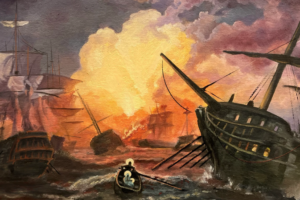Crisis—Our Lady of Guadalupe was there at Lepanto, hearkening to the Rosary recited by the soldiers processing round the decks, her quiet, pregnant power blazing at that apocalyptic battle with all the splendor of the star-crowned Woman of Revelation.
Most Catholics wouldn’t consider the motherly image of Our Lady of Guadalupe a martial image. The serene, pregnant Virgin—signified by the black sash expectant Aztec women wore—appeared to St. Juan Diego and upon his cactus-fiber tilma in 1531, a decade after Christianity came to the Mesoamerican people. In a tender vision to Diego’s uncle, the same Lady disclosed her name, “Santa Maria de Guadalupe,” though many  think the now-famous title is a mistranslation of “Coatlaloppe,” meaning “snake crusher,” which is anything but tender.
think the now-famous title is a mistranslation of “Coatlaloppe,” meaning “snake crusher,” which is anything but tender.
The manifestation and majesty of Our Lady of Guadalupe was always a conquering force, putting an end to the Aztec bloodshed with the unprecedented conversion of millions. Our Lady of Guadalupe completed the work of the Franciscans in appearing to her little son on Tepeyac Hill, claiming the territory once held by a temple to the mother goddess of the Aztecs, Tonantzin Coatlaloppe. She, too, was called the one who steps on serpents, but she was overthrown by another. Despite her peaceful aspect, Our Lady of Guadalupe has always blazed for battle.
The second week of Advent recalls the Woman of Revelation, whom Our Lady of Guadalupe represents—she who, “clothed with the sun, with the moon under her feet, and on her head a crown of twelve stars,” faced off “in the pangs of birth” against a crimson, seven-headed dragon. The Snake Crusher has always presided over the struggle between Heaven and Hell. In the expectation of her Son, Catholics enter into the expectation of this holy season and the cosmic warfare that Our Lady of Guadalupe serenely stands in the midst of as the Second Eve, who stood at the foot of the Cross to bruise the head of the serpent with her heel.
The presence of Our Lady of Guadalupe over conflicts has been recently depicted in an extraordinary painting by Catholic artist and architect Daniel A. Ezekiel Balan. The dramatic scene, executed in oils on canvas board, offers a very different vision of the Holy Family as they row across the battle line at Lepanto, where the great struggle for the West took place between the Holy League and the Ottoman Empire in 1571, 40 years after the miracles of Guadalupe.
This unique work of art depicts the union of two of the greatest surprises in history: the first being the Incarnation, and the second being the Christian victory against the seemingly invincible Ottoman fleet on the Gulf of Patras, off the western coast of Greece. Everyone knows the story of Lepanto’s madcap hero, Don John of Austria, issuing rosaries to his soldiers as weapons and ordering them to march in prayer about the decks with  fiery axioms such as “there is no paradise for cowards!” But not many know that his steadfast admiral, John Andrea Doria, had aboard his ship one of the first reproductions of Our Lady of Guadalupe.
fiery axioms such as “there is no paradise for cowards!” But not many know that his steadfast admiral, John Andrea Doria, had aboard his ship one of the first reproductions of Our Lady of Guadalupe.
Doria received it from King Philip II of Spain before setting out from Genoa with his flotilla. Pedro Moya de Contreras, the Archbishop of Mexico, knew of the impending conflict; so, he had a copy made of the powerful Native image, touched it to the original tilma, and sent it to Spain from the New World. Admiral Doria knelt before Our Lady of Guadalupe in the hold of his flagship when battle broke in an act of hopeful expectation to the Expecting Virgin, even as Don John danced on the prow of the Real when it collided with Ali Pasha’s Sultana, striking the Islamic banner that had the name of Allah stitched in gold 29,800 times.
Our Lady of Guadalupe was there at Lepanto, hearkening to the Rosary recited by the soldiers processing round the decks, her quiet, pregnant power blazing at that apocalyptic battle with all the splendor of the star-crowned Woman of Revelation, she who graces the… read full glorious article here.




You must be logged in to post a comment.